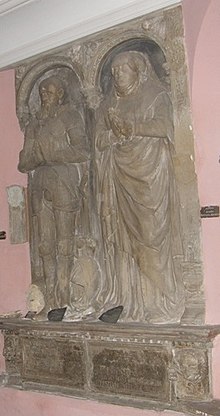Philip I (Nassau-Wiesbaden-Idstein)

Philip I of Nassau-Idstein (born April 26, 1492 in Cologne ; † June 6, 1558 in Idstein ) also known as " the old man" , was Count of Nassau-Wiesbaden-Idstein .
family
He was the only son of Count Adolf III. The mother was Margarete von Hanau-Lichtenberg (1463-1504). He himself was engaged to Ottilie von Nassau-Saarbrücken in 1501 , but married on August 24, 1514 in Bergen op Zoom Adriana von Hainaut-Bergen (* March 9, 1495, † June 27, 1524). With this he had six children.
Life
He followed his father as regent in 1511. In contrast to the latter, who had actively participated in imperial politics, Philip concentrated on the rule of his own territory. Only occasionally, as in Augsburg in 1530, did he take part in the Reichstag . In contrast, he took an active part in the meetings of the Wetterau Counts' Association to coordinate their common interests. Due to illness - he became almost completely blind - he did not always attend the meetings personally.
He himself remained a Catholic. But he took a more passive stance on the Reformation . He did not hinder these efforts, but at first he did not encourage them either. This led to certain problems in the properties that he shared with others and where the other masters promoted the Reformation. During the Peasants' War , riots broke out in Wiesbaden. Load reduction, free hunting, and other demands were made.
At the beginning of the 1540s he began to pursue a more pro-Reformation policy. In an ordinance of 1542, clergymen who were reformist were appointed. At the same time, an existing school in Wiesbaden was converted into a Latin school. Philip did not participate in the Schmalkaldic League , nor participated in the Schmalkaldic war or the Prince uprising against Charles V in part.
But he felt compelled to introduce the Augsburg Interim and to allow corresponding visitations. In 1552 his area was devastated by the soldiers of Margrave Albrecht Alcibiades . In the same year the Lutheran clergy returned and this denomination has been firmly established ever since. He settled disputes with neighboring princes amicably. He worried about the rebuilding of Wiesbaden after the city fire of 1547. However, he forbade Jews to stay in Wiesbaden in return for payment from the city.
The son Adolf was intended as regent for the Idstein rule. The son Philipp ( Philipp II the young man ) was to inherit the rulership of Wiesbaden and was co-regent during the father's lifetime. A third son, Balthasar, was a member of the Teutonic Order . Adolf died before he could take over the inheritance. Philipp, called Jungherr to distinguish himself from his father, inherited the entire property, but died in 1566, so that Balthasar left the order and took over the inheritance.
progeny
- Katharina (* 1515; † 1540) ⚭ 1538 with Johann III. von Hohenfels († 1573)
- Philip II (* 1516; † 1566)
- Margarethe (* 1517; † 1596), abbess in Walsdorf
- Adolf IV (* 1518; † 1556) ⚭ April 19, 1543 with Franziska von Luxemburg († 1566), daughter of Charles, Comte de Ligny , Brienne et Roussy (1488–1530), widow of Margrave Bernhard of Baden-Baden
- Magdalene (* 1546; † 1604) ⚭ September 9, 1566 with Count Joachim von Manderscheid-Schleiden (* 1539; † 1582)
- Balthasar (* 1520; † 1568) ⚭ June 9, 1564 with Margarethe von Isenburg-Büdingen (* 1542; † 1612/1613)
- Anna (* 1520; † 1594), nun in Walsdorf
literature
- Friedrich Otto: Philipp I. (Count of Nassau-Idstein and Wiesbaden) . In: Allgemeine Deutsche Biographie (ADB). Volume 26, Duncker & Humblot, Leipzig 1888, p. 13 f. (Note: with wrong year of birth)
Individual evidence
- ^ Count Philipp I of Nassau-Wiesbaden-Idstein 1558, Idstein. Grave monuments in Hesse until 1650. (Status: February 24, 2005). In: Landesgeschichtliches Informationssystem Hessen (LAGIS).
- ↑ Adriana was the second daughter of Johann III. by Glymes and his wife Adrienne de Brimeu († 1500).
| personal data | |
|---|---|
| SURNAME | Philip I. |
| ALTERNATIVE NAMES | Philip I of Nassau-Idstein; Philip I of Nassau-Wiesbaden-Idstein |
| BRIEF DESCRIPTION | Count of Nassau-Wiesbaden-Idstein |
| DATE OF BIRTH | April 26, 1492 |
| PLACE OF BIRTH | Cologne |
| DATE OF DEATH | June 6, 1558 |
| Place of death | Idstein |